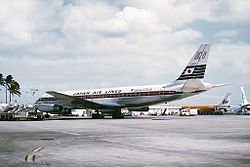Japan Air Lines Flight 472 (1977)
 JA8033, the aircraft involved in the hijacking, at Honolulu International Airport in 1969 | |
| Hijacking | |
|---|---|
| Date | 28 September 1977 |
| Summary | Hijacking |
| Site | Dhaka International Airport, Bangladesh |
| Aircraft | |
| Aircraft type | Douglas DC-8-62[1] |
| Operator | Japan Air Lines |
| Registration | JA8033[2] |
| Flight origin | Charles de Gaulle Airport, Paris, France |
| Stopover | Santacruz Airport, Bombay, India |
| Destination | Tokyo International Airport, Tokyo, Japan |
| Passengers | 142 (including 5 hijackers) |
| Crew | 14 |
| Fatalities | 0 |
| Survivors | 156 (all) |
Japan Air Lines Flight 472 was an aircraft hijacking carried out by the Japanese Red Army (JRA) on 28 September 1977.
Incident
[edit]The Douglas DC-8, en route from Paris to Haneda Airport in Tokyo with 156 people on board, stopped in Bombay, India. Shortly after taking off from Bombay, five armed JRA members, led by Osamu Maruoka, hijacked the aircraft and ordered it flown to Dhaka, Bangladesh. At Dhaka, the hijackers took the passengers and crew hostage, demanding US$6 million and the release of nine imprisoned JRA members.[3] The Chief of Air Staff of Bangladesh Air Force, AG Mahmud, negotiated with the hijackers from the control tower.[4] Things were further complicated at the airport when on 1 October 1977 Bangladesh Air Force mutinied with the lead negotiator almost being killed.[5] The next day (29 September), five hostages were released, including American actress Carole Wells,[3] who was on her honeymoon with her husband, former California assemblyman Walter J. Karabian.[6] Karabian remained on board.
On 1 October Prime Minister Takeo Fukuda announced that the Japanese government would accept the hijackers' demands, on the principle that "the life of a single person outweighs the earth." Six of the imprisoned JRA members were then released.[1]
A chartered Japan Airlines flight carried the money and the six released JRA members to Dhaka, where the exchange took place on 2 October. The hijackers released 118 passengers and crew members. On 3 October, they flew to Kuwait City and Damascus, where they released eleven more hostages. Finally, the aircraft was flown to Algeria, where it was impounded by authorities and the remaining hostages were freed.[1]
List of hijackers and released prisoners
[edit]| Fugitives’ portraits from the official website of The Metropolitan police departments (in Japanese) | |
|---|---|
Hijackers
[edit]- Osamu Maruoka (丸岡 修, Maruoka Osamu) , caught in 1987 when he attempted to enter Japan on a false passport. A life sentence was finalized in 2000, and he died of a heart problem in 2011 in prison.
- Norio Sasaki (佐々木 規夫, Sasaki Norio) , is still at large
- Kunio Bandō (坂東 國男, Bandō Kunio), is still at large
- Jun Nishikawa (西川 純, Nishikawa Jun)
- Haruo Wakō (和光 晴生, Wakō Haruo), hasn't been charged with this hijacking
Released prisoners
[edit]- Junzō Okudaira (奥平 純三, Okudaira Junzō), is still at large
- Tsutomu Shirosaki (城崎 勉, Shirosaki Tsutomu)
- Ayako Daidōji (大道寺 あや子, Daidōji Ayako), is still at large
- Yukiko Ekida (浴田 由紀子, Ekida Yukiko)
- Hiroshi Sensui (泉水 博, Sensui Hiroshi)
- Akira Nihei (仁平 映, Nihei Akira), is still at large
Aftermath
[edit]The incident contrasted the European and American approach of non-negotiation with terrorists to Japan's approach of appeasing terrorists if necessary. Shortly after the incident, Japan's National Police Agency established a Special Assault Team to deal with future acts of terrorism.[7] Several of the JRA terrorists involved in the hijacking have yet to be apprehended and their current whereabouts are unknown.[8]
Osamu Maruoka, who also led the hijacking of Japan Air Lines Flight 404 in 1973, escaped and remained a fugitive until 1987 when he was arrested in Tokyo after entering Japan on a forged passport. Given a life sentence, he died in prison on 29 May 2011.[9] Another of the hijackers, Jun Nishikawa, eventually returned to Japan, was arrested, convicted and sentenced to life imprisonment.[10]
See also
[edit]Notes
[edit]- ^ a b c Schreiber, p. 216.
- ^ JA8033 ダッカ ハイジャック政府派遣特別機 添乗整備記録 Archived 5 March 2014 at the Wayback Machine()(in Japanese)
- ^ a b "Japan agrees to terrorists' demand to free nine prisoners". The Herald (Jasper, Indiana). 29 September 1977. p. 3. Retrieved 20 October 2022.
- ^ "Former Bangladesh Air Force chief AG Mahmud to receive Japan Imperial Decoration". bdnews24.com. Retrieved 13 December 2022.
- ^ Islam, Shariful; Khan, Mohammad Jamil (8 May 2017). "Japan still remembers his heroics". The Daily Star (Dhaka, Bangladesh). Retrieved 13 December 2022.
- ^ "Japan agrees to pay hijackers ransom". Idaho State Journal. 29 September 1977. p. 1. Retrieved 20 October 2022.
- ^ Itō (2004), pp. 46–51.
- ^ Schreiber, p. 216–217.
- ^ "Ex-Red Army member Maruoka dies", Japan Times, 30 May 2011.
- ^ Kyodo News, "Japanese Red Army member's life sentence to stand", The Japan Times, 15 September 2011, p. 2.
References
[edit]- Itō, Kōichi (2004). The truth of the Metropolitan Police Special unit (in Japanese). Dainihon-kaiga. ISBN 978-4499228657.
- Schreiber, Mark (1996). Shocking Crimes of Postwar Japan. Tuttle Publishing. ISBN 4-900737-34-8.
Further reading
[edit]- Wells, Carole HIJACKED: An Eyewitness Account of Evil (MotherBird Productions, 14 September 2018, ISBN 978-1732490901)
- Mahmud, A. G. "My Destiny" (Academic Press and Publishers Library 2013, ISBN 9840803018)
- 1977 in Japan
- 1977 in Bangladesh
- Aircraft hijackings in Asia
- Aviation accidents and incidents in Bangladesh
- Aviation accidents and incidents in 1977
- Hostage taking in Bangladesh
- Japan Airlines accidents and incidents
- Accidents and incidents involving the Douglas DC-8
- 1977 crimes in Bangladesh
- September 1977 events in Asia
- Terrorist incidents in Japan in 1977
- 1977 crimes in Japan
- 1977 crimes
- September 1977 events
- Japanese Red Army
- Hijackings in 1977
